When Should You Worldbuild for Your Novel?
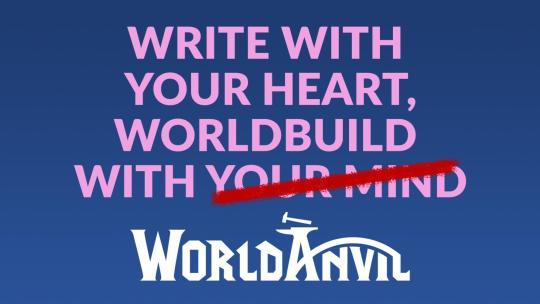
Every year, we’re lucky to have great sponsors for our nonprofit events. World Anvil, a 2020 NaNo sponsor, is a writing software that helps you develop and organize your characters, plot and world setting. Today, World Anvil Director Janet Forbes shares some tips for worldbuilding at all stages of your novel:
As a writing and worldbuilding expert, and the director of the award-winning worldbuilding and novel writing software World Anvil, I get asked this question a lot: at which stage during the novel writing process should you be worldbuilding? Should you be worldbuilding as you plot, as you draft, or as you edit? And—I see you out there, you glorious pantsers—what if you don’t plot? When should you be worldbuilding?
A quick disclaimer & explanation:EVERYONE IS DIFFERENT! (Isn’t it beautiful?) This post is full of suggestions. If in doubt, try things out! But not everything will work for everyone. Experiment with these ideas, and develop a novel writing process that works for you!Some of the best worldbuilding articles are only a few sentences—just long enough to document your ideas! You’ll probably expand them a bit through the drafting process as you discover or decide more details. But don’t feel you have to write the entire “Silmarillion” for your world! Longer articles often just mean more to read through when you’re in a hurry.When to worldbuild as a Plotter?Are you a plotter? Prefer to take a run at a first draft with a solid plan? Then here are some of the best places to work worldbuilding into your novel writing method!
Worldbuild the big stuff during the plotting phase
As a plotter, a lot of the big worldbuilding ideas probably come as you plot your novel. You’ll need characters who live in settlements, and were probably educated in organizations. They may or may not adhere to certain traditions or religions. You might add magic systems, supernatural powers, and/or futuristic technology (which you’ll need to know the limitations of!). Writing down your ideas NOW means that you have them safe, and won’t lose them!
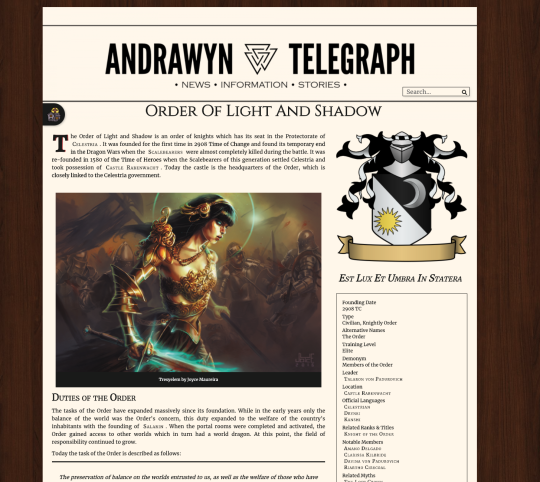
Worldbuilding your organizations, like Nations, Religions, Jedis, Police Forces and Universities, will help give them more impact, and make your world feel more dynamic and real!
Image Credit: Davina, made on World Anvil.
If your novel is an event novel—aliens invade, the Earth quakes, or a zombie virus is let loose—then write a bit about the nature of the threat. If you’re creating a character novel, make sure you have some notes on your main character’s background, mentors, relationships, education and skills.
Worldbuilding these elements of your plot—even in just a few notes—before you start the first draft will really help you down the line! You can plan all of these out using the worldbuilding templates in World Anvil. They give you the freedom to create WHATEVER you want, help you connect everything together, and make everything searchable when you need it!
Worldbuilding during Draft 1—character experience and juicy details!
So, if you’re anything like me, you’ll probably find that something magical happens during your first draft. You start to consider your world through your character’s eyes! This means adding a lot of details to your worldbuilding—both SHOWING rather than TELLING, and sensory detail.
For example, you won’t tell your readers that an organization is evil. Instead, you can show a poor man in the stocks because he couldn’t afford his tithe or tax. Add that punishment to the worldbuilding article about the evil organization, so you can remember it for later (or for book 2!).
Also, as your characters interact with places and people, they’ll feel, smell and hear (and maybe taste) details which heighten the experience. This makes your writing more evocative, and invites readers to feel they’re living in your novel, too!
Add these details—you can even copy-paste relevant paragraphs as quotes—into your worldbuilding articles. Some Plotters prefer to do this scene by scene as they write their first draft. Others (like me!) prefer to do this as a separate stage, once the first draft is done. Read through the first draft, and add quotations or details into your worldbuilding articles. Future-you will thank you!
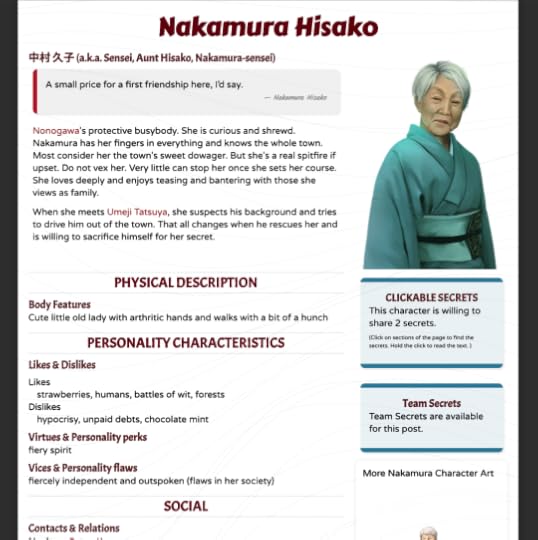
A fantastic example of a quick character profile! Hotlinks (shown here in red) help you link everything together in your world, so you can find things easily!
Image Credit: ShyRedFox, created on World Anvil
Worldbuilding as a Panster!If you’d rather fly by the seat of your pants than plot out each step of your novel, then congratulations—you’re a Panster! You probably love the exciting feeling of discovering your story as you write your first draft. So here are some ways you can work worldbuilding into your novel writing process!
Characters are worldbuilding too!
Most pantsers I know love to craft characters, even if they don’t know what will happen to them over the course of the story! And characters are full to the brim with worldbuilding opportunities!
For example, the places your characters were born, went to school, travelled—they are all important locations to worldbuild in a few sentences. Which country is your character from? Do they fit in and, if not, which traditions or view points do they chafe against? These are all excellent places to start your worldbuilding, even before NaNoWriMo has started. You’ll still be pantsing—just Pantsing with Purpose!
And remember, none of these ideas are set in stone - you can always change them later. It’s just a jumping off point, to give you inspiration.
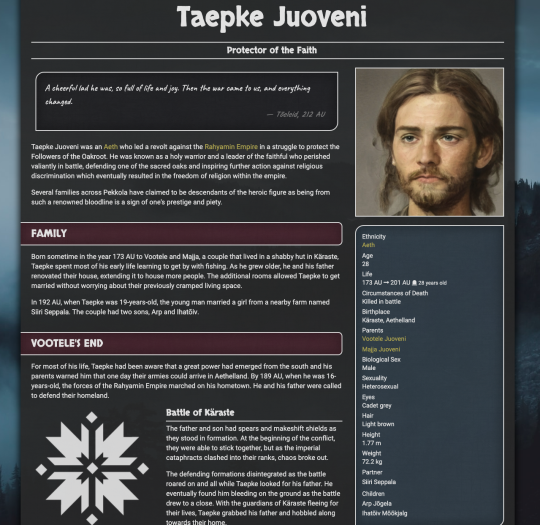
Characters are worldbuilding too! Writing out a detailed character profile is a great way to discover more about your main character. World Anvil provides prompts to help you flesh out your characters even more.
Image Credit: Dhelian, created on World Anvil
Plan worldbuilding using the “Jot, Bin, Pants” method!
The Jot, Bin, Pants method (originally developed by Cassandra Lee Yieng) is a way to plan without plotting! Once you have those scenes, scan through them quickly. You’ll already spot elements you can write short worldbuilding articles about! If a scene takes place in a ship, a smart townhouse, or an abandoned castle, write a few sentences about that space. What material is it built from? What feelings does it conjure up?
Now you have a few notes on that location, you’ll be able to recapture the feeling much more quickly during crunch time, and get your words written!
Keep worldbuilding notes during Draft 1
Another helpful moment to make notes is at the end of each writing session during Draft 1. Try spending 5 minutes documenting the people, places and things you came up with. World Anvil’s tree layout can give you a lot of inspiration when you’re glancing over your setting to decide what should happen next! So if you mention a creature, a character, a location or a technology, scribble down a few notes about your ideas. You never know - it might save your character’s life!
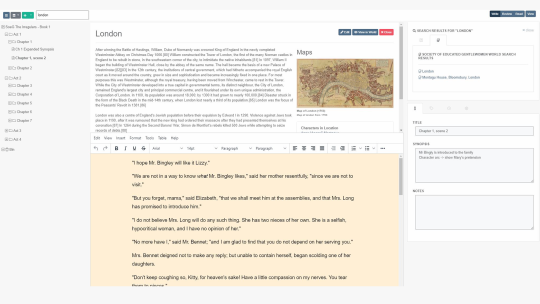
With World Anvil’s novel writing software, you can easily reference your worldbuilding and update your series bible either AS you write, or after each writing session!
The worldbuilding review phaseRegardless of Plotterism or Pantitude, you should eventually have Draft 1 of a book! Granted, it probably needs some tweaks right now. But there’s a story there, characters, ideas, and an ending. Congratulations!
Now is a great time to take stock of your worldbuilding. As you read through your novel, build up your world bible or series bible. Make sure you have articles for each major character, for the places and things you’ve introduced - just a few sentences is fine. But as you edit and flesh out your novel, these will be great references to have, and it’ll speed up the next phase no end!
Worldbuilding and Structural EditsDuring structural edits, i.e. re-editing the actual story and big ideas of your book, you’ll find that keeping an updated version of your series bible is really useful! You can do this as you edit (which is what I prefer) or at the end of each draft.
By the time you’re at line edits, you’ll be done with your worldbuilding… and ready to get on with your novel’s sequel! And I can promise you - you’ll be thanking past-you for keeping such good worldbuilding notes in your Series Bible!
If you want to keep your worldbuilding organized and instantly available in your novel writing software interface, then check out World Anvil! We’re recommended by Writer’s Digest, as well as bestselling authors like Brian McClellan, Chris Fox, Jenna Moreci, and literally a million other writers and worldbuilders! You can also pick up a 25% discount with the coupon code NANOWRIMO!
 Become the ultimate writer and worldbuilder : NaNoWriMo participants get 25% off World Anvil!
Become the ultimate writer and worldbuilder : NaNoWriMo participants get 25% off World Anvil!Whatever you’re writing, and whenever you worldbuild, World Anvil will help to develop and organize your characters, plot and world setting, link everything together, and write your novel in our integrated novel writing software!
And right now you can bag 25% off 6 & 12 month memberships of Master Tier and above, using the coupon code NANOWRIMO on checkout!

Janet Forbes (pen name J.D. Blythe) is a published author and the Director of World Anvil, the ultimate worldbuilding and novel writing platform! This award-winning software helps you organize, store and track your worldbuilding as you’re writing your novel. Our novel writing software, accessible from anywhere, integrates stunningly with your worldbuilding. And when it’s time to publish, you can export, or publish directly on the World Anvil platform and monetize YOUR way! Check it out at World Anvil.
Chris Baty's Blog
- Chris Baty's profile
- 63 followers



